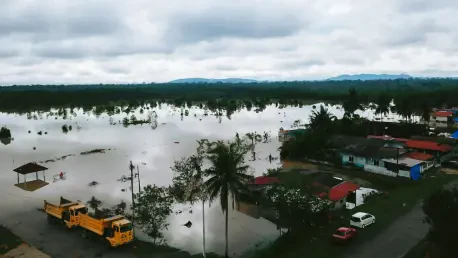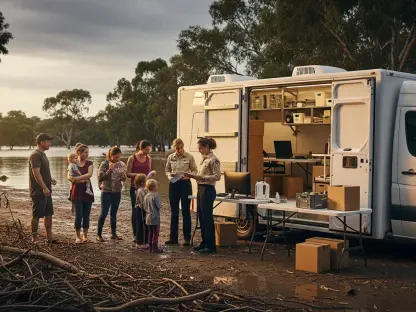Flooding poses an increasing threat across the United States, amplified by climate change-induced weather patterns. Despite the widespread risk faced by homeowners, a staggering reality emerges: merely 4% of homeowners are covered by flood insurance, as noted by the Federal Emergency Management Agency (FEMA). This discrepancy, referred to as the “flood insurance gap,” represents a grave misalignment between the genuine risks faced and the preparedness of property owners. Expanding flood insurance adoption emerges as a critical concern, necessitating a deeper understanding of its intricacies to bridge this growing divide effectively.
Uncovering Risks and Insufficiencies
The Limitations of Standard Homeowners’ Policies
Standard homeowners’ insurance predominantly excludes coverage for flood-related damages, rendering many properties susceptible in the wake of flooding disasters. Although aid from FEMA is available for federally declared disasters, it often only marginally offsets the extensive repair costs incurred by individuals. Consequently, many homeowners find themselves grappling with substantial financial burdens post-flood, underscoring the critical need for comprehensive insurance solutions. This inadequacy highlights an urgent imperative for enhancing awareness about the financial vulnerabilities tied to flood events and exploring viable policy options to address them more effectively.
Furthermore, rising global temperatures contribute to more severe atmospheric conditions, where increased rainfall intensity becomes a recurring hazard. Recent flooding incidents in regions like Texas, New Mexico, and North Carolina exemplify the amplification of risks due to climatic shifts. The prevalence of these conditions accentuates the urgency for homeowners to adopt preventive measures, including securing flood insurance. As floods become more frequent and devastating, fostering awareness about the potential ruinous impacts and encouraging better preparedness through insurance solutions is paramount.
The Elevation of Flood Insurance Costs
Flood insurance, while offering a viable pathway for financial protection, is predominantly accessed through FEMA’s National Flood Insurance Program (NFIP). Despite this availability, the premium costs often deter individuals from obtaining necessary coverage. Residents in flood-prone areas, such as Louisiana’s Plaquemines Parish, face annual premiums that have surged beyond $5,400, representing a 500% increase. This exorbitant cost structure poses a prohibitive barrier for many, especially those with limited financial means. The challenge lies in finding a balance between providing adequate coverage and ensuring that it remains accessible to those who need it the most.
Even as efforts are made to incentivize insurance adoption, the realities of managing such financial responsibilities weigh heavily on property owners. The struggle of balancing insurance expenses with other household costs underscores an urgent need for recalibrating insurance frameworks to ensure they serve a wider populace. Faced with premium hikes stemming from individual risk assessments, many homeowners remain wary of the financial viability of maintaining flood coverage, rendering proactive engagement and policy evolution crucial for sustainable risk management.
Navigating the Complexities of Flood Insurance
The Historical Context and Structural Challenges of the NFIP
The NFIP, established in response to private insurers’ reluctance to cover flood risks, has faced its set of challenges. Since its inception in 1968, the program has continually grappled with debt and has often required loans from the Treasury to meet its obligations. This financial dependence highlights the structural vulnerabilities within the program and emphasizes the need for reform. FEMA has endeavored to address these issues by revamping the NFIP’s pricing models, adopting a more nuanced approach that incorporates both property value and flood risk to calculate premiums.
The revamped pricing model aims to incentivize risk mitigation through individual responsibility. However, this shift has led to significant premium increases in some regions, raising concerns among property owners. The balance lies in aligning risk assessments with affordability to ensure broader program participation, thereby bolstering community resilience. Policymakers and stakeholders are tasked with navigating the delicate equilibrium between sustaining the NFIP’s financial integrity and ensuring accessibility to those it serves.
The Imperative of Regulatory and Financial Reforms
Regulation mandates certain high-risk zone properties with government-backed mortgages to secure flood insurance. Failure to comply with this requirement disqualifies homeowners from receiving federal disaster aid in the future, further exacerbating their vulnerability. Additionally, insurance providers like Citizens Property Insurance Corporation in Florida mandate flood insurance for homes covered for wind damage, stressing the interdependency between different types of coverage.
Experts advocate that increasing flood insurance policyholders would potentially drive down costs and stimulate private sector involvement. By lowering the entry barrier for private insurers, the market could see increased competition, fostering more affordable pricing structures in the long run. However, public skepticism about flood insurance remains entrenched, driven by a lack of perceived necessity outside designated high-risk zones. To bridge this perceptual gap, a concerted effort in communication and education is integral, enabling communities to understand and respond effectively to flood risks.
Future Perspectives and Pragmatic Solutions
Encouraging Broader Insurance Adoption
Incentivizing broader adoption of flood insurance requires addressing public misconceptions and highlighting the importance of coverage even outside high-risk zones. Many individuals underestimate their exposure, often associating flood insurance with coastal regions only. Deploying educational initiatives that clarify the nature of flood zones and uninsured risks could foster a well-informed society ready to embrace insurance as a necessary safeguard. Community engagement strategies, coupled with targeted outreach efforts, play a vital role in demystifying the process and reinforcing its importance across diverse geographic settings.
Moreover, leveraging technological advancements, such as predictive analytics and real-time risk assessment tools, can aid in creating dynamic flood risk maps. These tools offer homeowners clearer insights into their unique risk profiles, enabling better-informed decisions regarding coverage. By fostering a connection between technological innovation and risk perception, stakeholders can cultivate a culture that prioritizes proactive risk management.
Economic and Policy Implications
Flooding is an escalating threat in the U.S., worsened by climate change that triggers unpredictable weather events. However, despite this growing danger, only about 4% of American homeowners have flood insurance, according to the Federal Emergency Management Agency (FEMA). This significant gap, termed the “flood insurance gap,” highlights a troubling misalignment between the actual risk homeowners face and their level of preparedness. The low rate of insurance coverage against flood damage underscores a widespread lack of readiness and understanding of potential hazards. Addressing this issue requires urgent action to promote broader adoption of flood insurance. Promoting awareness and education about the importance of flood insurance is crucial. Many property owners are unfamiliar with the true risks floods pose to their homes and mistakenly believe that standard homeowners insurance covers flood damage. Closing this gap is imperative to ensuring people’s financial protection against unpredictable environmental threats.









